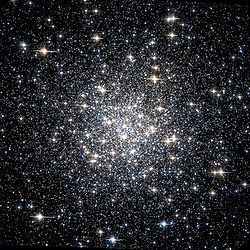Messier 56 (also known as M56 or NGC 6779) is a globular cluster in the constellation Lyra.[a] It was discovered by Charles Messier in 1779.[b] It is angularly found about midway between Albireo (Beta (β) Cygni) and Sulafat (Gamma (γ) Lyrae). In a good night sky it is tricky to find with large (50–80 mm) binoculars, appearing as a slightly fuzzy star.[9] The cluster can be resolved using a telescope with an aperture of 8 in (20 cm) or larger.[10]
| Messier 56 | |
|---|---|
 Messier 56 by Hubble Space Telescope. 3.6′ view | |
| Observation data (J2000 epoch) | |
| Class | X[1] |
| Constellation | Lyra |
| Right ascension | 19h 16m 35.57s[2] |
| Declination | +30° 11′ 00.5″[2] |
| Distance | 32.9 kly (10.1 kpc)[3] |
| Apparent magnitude (V) | 8.3[4] |
| Apparent dimensions (V) | 8.8'[4] |
| Physical characteristics | |
| Mass | 2.30×105[5] M☉ |
| Radius | 42 ly[6] |
| Metallicity | = –2.00[7] dex |
| Estimated age | 13.70 Gyr[7] |
| Other designations | M56, NGC 6779, GCl 110, C 1914+300[8] |
M56 is about 32,900 light-years away from Earth[3] and measures roughly 84 light-years across, containing 230,000[5] solar masses (M☉). It is about 31–32 kly (9.5–9.8 kpc) from the Galactic Center and 4.8 kly (1.5 kpc) above the galactic plane.[11] This cluster has an estimated age of 13.70 billion years and is following a retrograde orbit through the Milky Way. The properties of this cluster suggest that it may have been acquired during the merger of a dwarf galaxy, of which Omega Centauri forms the surviving nucleus. For Messier 56, the abundance of elements other than hydrogen and helium, what astronomers term the metallicity, has a very low value of [Fe/H] = –2.00 dex which is 1⁄100 of the abundance in the Sun.[7]
The brightest stars in M56 are of 13th magnitude, while it contains only about a dozen known variable stars, such as V6 (RV Tauri star; period: 90 days) or V1 (Cepheid: 1.510 days);[12] other variable stars are V2 (irregular) and V3 (semiregular). In 2000, a diffuse X-ray emission was tentatively identified coming from the vicinity of the cluster. This is most likely interstellar medium that has been heated by the passage of the cluster through the galactic halo. The relative velocity of the cluster is about 177 km s−1, which is sufficient to heat the medium in its wake to a temperature of 940,000 K.[13]
M56 is part of the Gaia Sausage, the hypothesised remains of a merged dwarf galaxy.[14]
Gallery
editSee also
editReferences and footnotes
edit- ^ Shapley, Harlow; Sawyer, Helen B. (August 1927), "A Classification of Globular Clusters", Harvard College Observatory Bulletin, 849 (849): 11–14, Bibcode:1927BHarO.849...11S.
- ^ a b Goldsbury, Ryan; et al. (December 2010), "The ACS Survey of Galactic Globular Clusters. X. New Determinations of Centers for 65 Clusters", The Astronomical Journal, 140 (6): 1830–1837, arXiv:1008.2755, Bibcode:2010AJ....140.1830G, doi:10.1088/0004-6256/140/6/1830, S2CID 119183070.
- ^ a b Ivanov, Valentin D.; et al. (2000). "Near Infrared Photometry of Galactic Globular Clusters M56 and M15. Extending the Red Giant Branch vs. Metallicity Calibration Towards Metal Poor Systems". arXiv:astro-ph/0002118.
- ^ a b "Messier 56". SEDS Messier Catalog. Retrieved 29 April 2022.
- ^ a b Boyles, J.; et al. (November 2011), "Young Radio Pulsars in Galactic Globular Clusters", The Astrophysical Journal, 742 (1): 51, arXiv:1108.4402, Bibcode:2011ApJ...742...51B, doi:10.1088/0004-637X/742/1/51, S2CID 118649860.
- ^ From trigonometry: radius = distance × sin( diameter_angle / 2 ) = 32,900 × sin(8.8′/2) = 42.1 ly.
- ^ a b c Forbes, Duncan A.; Bridges, Terry (May 2010), "Accreted versus in situ Milky Way globular clusters", Monthly Notices of the Royal Astronomical Society, 404 (3): 1203–1214, arXiv:1001.4289, Bibcode:2010MNRAS.404.1203F, doi:10.1111/j.1365-2966.2010.16373.x, S2CID 51825384
- ^ "M 56". SIMBAD. Centre de données astronomiques de Strasbourg. Retrieved 2006-11-16.
- ^ Thompson, Robert Bruce; Thompson, Barbara Fritchman (2007), Illustrated guide to astronomical wonders, DIY science, O'Reilly Media, Inc., p. 311, ISBN 978-0-596-52685-6
- ^ Inglis, Mike (2004), Astronomy of the Milky Way: Observer's guide to the northern sky, vol. 1, Springer, p. 90, Bibcode:2003amwn.book.....I, ISBN 978-1-85233-709-4
- ^ Bica, E.; et al. (April 2006), "Globular cluster system and Milky Way properties revisited", Astronomy and Astrophysics, 450 (1): 105–115, arXiv:astro-ph/0511788, Bibcode:2006A&A...450..105B, doi:10.1051/0004-6361:20054351, S2CID 1559058
- ^ Pietrukowicz, P.; et al. (June 2008), "CURiuos Variables Experiment (CURVE): Variable Stars in the Metal-Poor Globular Cluster M56", Acta Astronomica, 58: 121–130, arXiv:0806.1515, Bibcode:2008AcA....58..121P
- ^ Hopwood, M. E. L.; et al. (July 2000), "A possible detection of diffuse extended X-ray emission in the environment of the globular cluster NGC 6779", Monthly Notices of the Royal Astronomical Society, 316 (1): L5–L8, Bibcode:2000MNRAS.316L...5H, doi:10.1046/j.1365-8711.2000.03717.x
- ^ Myeong, G. C; Evans, N. W; Belokurov, V; Sanders, J. L; Koposov, S. E (2018). "The Sausage Globular Clusters". The Astrophysical Journal. 863 (2): L28. arXiv:1805.00453. Bibcode:2018ApJ...863L..28M. doi:10.3847/2041-8213/aad7f7. S2CID 67791285.
- ^ Specifically in the center-northwest of Lyra which makes it visible from everywhere above about the 50th parallel south. However the Sun passes through Sagittarius far to the south (or technically the Earth orbits so as to make the Sun seem to do so) throughout December. This also makes the cluster mostly risen during day, not night, in the nearest months but will never impede pre-dawn and post-sunset views from the upper half of northerly latitudes.
- ^ on January 19
External links
edit- Messier 56, SEDS Messier pages
- Messier 56, Galactic Globular Clusters Database page
- Hubble snaps a collection of ancient stars, August 26, 2012, TG Daily
- Crowther, Paul; Szymanek, Nik; Merrifield, Mike. "M56 – Globular Cluster". Deep Sky Videos. Brady Haran.
- Messier 56 on WikiSky: DSS2, SDSS, GALEX, IRAS, Hydrogen α, X-Ray, Astrophoto, Sky Map, Articles and images
![{\displaystyle {\begin{smallmatrix}\left[{\ce {Fe}}/{\ce {H}}\right]\end{smallmatrix}}}](https://wikimedia.org/api/rest_v1/media/math/render/svg/4c0821bd80891e071c08e7c7ee8e022baedf522c)